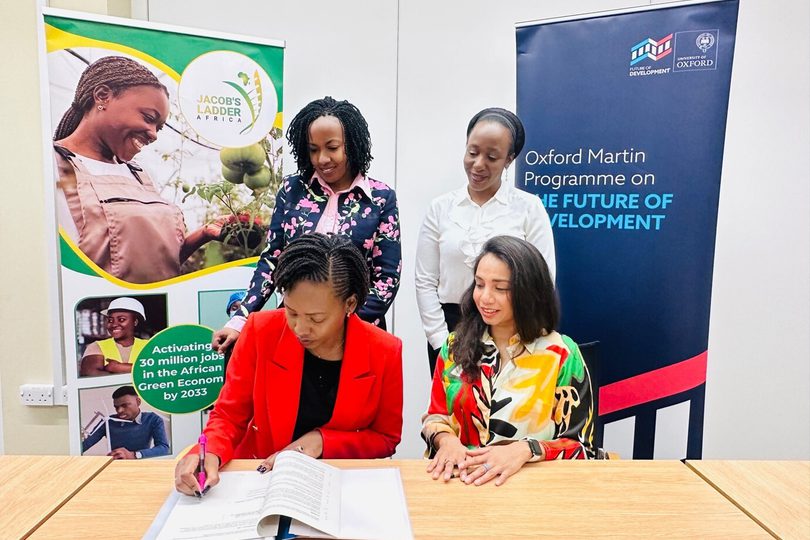
Jacob’s Ladder Africa (JLA) and the Oxford Martin Programme on the Future of Development have joined forces to conduct research on livelihoods and jobs within Africa’s green economy.
Launched in early 2023, the collaboration involves developing a research agenda aligned with JLA’s green economy expertise as well as envisaging the next steps Future of Development and JLA will take to jointly develop a Green Jobs Tool – an adaptable tool that aims to empower African policymakers to prioritise both economic growth and sustainable practices with an initial pilot in Kenya, Nigeria, and South Africa. The partnership also explores how JLA’s work with future youth entrepreneurs can be adapted and scaled to leverage growing opportunities in Kenya’s green economy.
'We recently got the mandate of mobilising different actors, and as Jacob's Ladder we are bringing together the development partners, the government, the academia, and then the youth of course. And we are leading the process of developing a legislative framework for Kenya on green jobs and green skills development,' said Sellah Bogonko, CEO of Jacob’s Ladder.
As global leaders prioritise the transition to a sustainable economy, a significant challenge remains: ensuring job creation and skills development for the 1 billion young people entering the labour market in the next decade. The demand for workers with green skills will inevitably increase over time in response to the worsening climate change crisis. Evidence suggests skills reduce labour market frictions and in turn, create better employment outcomes. Yet, there is little evidence on which skills can be constituted as green and, in turn, which jobs can be characterised as green jobs.
The most prominent definition for green jobs comes from the International Labour Organisation and is described as 'decent jobs that contribute to preserve or restore the environment, be they in traditional sectors such as manufacturing and construction, or in new, emerging green sectors such as renewable energy and energy efficiency.' However, this definition remains open to multiple interpretations creating significant challenges for measurement, standardisation and cross-country comparisons. Thus, it is imperative to study and better understand the green skills and jobs landscape and make it accessible for public consumption.
We are leading the process of developing a legislative framework for Kenya on green jobs and green skills development.
Africa’s persistent youth unemployment crisis also presents a unique challenge for policymakers, demanding a delicate balance between job creation and the promotion of environmentally sustainable practices. A mapping of the green skills gap along with an adaptable tool or index is necessary to equip governments for monitoring green job creation in their respective countries. As such, a tool to measure green jobs can provide policymakers with evidence allowing them to divert efforts and resources towards sectors that create green jobs and opportunities.
It is hoped this partnership can help address these challenges through the measurement of green jobs for Kenya and other low- and middle-income countries increasingly facing the green transition. Although a number of indices capture variable aspects of green jobs at sub-national or sectoral level, there still remains a major gap for measuring the scope for green jobs at national level spanning across nations and industries.
'There has to be a way where we should be able to link the funding to the impact. There has to be a way of measuring. For example, if you are creating jobs, the translation back in terms of reporting should be: how many jobs have you created?' added Bogonko.
The Future of Development and JLA collaboration culminated in a Nairobi roundtable event titled 'Green Livelihood Roundtable: Skills Development', co-hosted by both parties. This event brought together leading figures from academia, industry, international development, and youth populations.
The partnership itself formally launched today (Wednesday) with a design workshop that brought together key stakeholders.